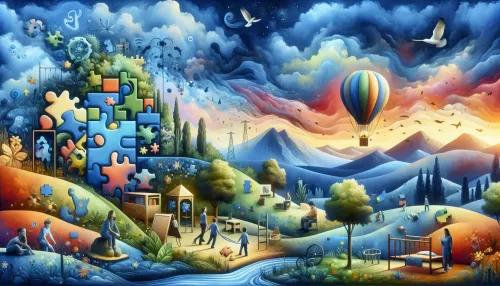
Harmonizing Paints and Potions: Exploring the Interplay of Art and Therapeutic Science for Autistic Children

Art has always been an incredible medium for self-expression, and when it intertwines with therapeutic science, its potential to positively impact autistic children becomes even more profound. This article delves into the fascinating intersection of art and biology, unraveling therapeutic insights through artistic expression, and elucidates the invaluable role of art in holistic autism care.
The Intersection of Art and Biology: Unveiling Therapeutic Insights Through Artistic Expression
Art serves as a powerful tool for communicating emotions and thoughts, especially for individuals with autism who may find verbal expression challenging. The creative process inherent in art enables autistic children to convey their feelings, perceptions, and experiences in a non-verbal manner, offering therapists and caregivers invaluable insights into their inner worlds. Furthermore, the act of creating art fosters a sense of accomplishment and self-worth, nurturing the emotional well-being of autistic individuals.
Integrating art into therapeutic sessions not only facilitates introspection but also promotes sensory stimulation and cognitive development. Through artistic expression, autistic children engage in activities that enhance their fine motor skills, spatial awareness, and hand-eye coordination. This multisensory experience not only enriches their engagement with the world but also provides a platform for holistic cognitive development, aligning with the core principles of autism intervention.
In essence, art serves as a bridge that connects the complexities of autism with the realms of emotional expression and self-discovery.
Therapeutic Techniques: Utilizing Art as a Medium for Expressive and Behavioral Enhancements in Autism Care
Art-based interventions form an integral part of holistic autism care, offering a diverse range of therapeutic techniques tailored to address specific behavioral challenges. From painting and sculpting to collage-making and drawing, each artistic modality provides a unique avenue for autistic children to explore their emotions and enhance their communication skills.
One remarkable aspect of utilizing art in autism care lies in its capacity to foster social interactions. Group art activities create nurturing environments where autistic children learn to share materials, express themselves in the presence of others, and collaborate on creative projects. These collaborative experiences play a pivotal role in cultivating social skills and promoting a sense of community among autistic individuals.
Moreover, the process of creating art empowers autistic children to regulate their emotions and behavior. As they immerse themselves in artistic endeavors, they learn to manage frustration, anxiety, and sensory overload, channeling these emotions into constructive outlets. This emotion-regulating aspect of art not only contributes to the overall well-being of autistic individuals but also equips them with valuable coping mechanisms essential for daily life.
Coloring Within the Lines of Chemistry: How Art Engages Autistic Minds in Therapeutic Learning
Beyond its expressive and behavioral benefits, art holds immense potential for facilitating therapeutic learning experiences tailored to the unique needs of autistic children. Incorporating scientific elements into art sessions not only enriches the learning process but also nurtures a deeper understanding of fundamental scientific principles.
By seamlessly integrating colors, patterns, and textures with scientific concepts, autistic children engage in experiential learning that transforms abstract theories into tangible manifestations. For instance, exploring color mixing not only enhances their artistic abilities but also instills foundational knowledge about primary and secondary colors based on scientific principles. Such interdisciplinary engagements enable autistic individuals to perceive scientific theories through hands-on experiences, transcending traditional pedagogical methods.
The fusion of art with therapeutic learning offers a dynamic platform where abstract concepts are rendered accessible through creative expression, unlocking new avenues for intellectual growth within the realm of autism care.
Painting Paths to Progress: Integrating Science-informed Therapeutic Approaches with Creative Art Sessions
In recent years, emerging research has emphasized the significance of science-informed therapeutic approaches within art interventions tailored for autistic children. By combining evidence-based practices with creative art sessions, therapists and caregivers can maximize the impact of artistic endeavors on cognitive development and emotional well-being.
For instance, incorporating elements of neurobiology and psychological principles into art therapy sessions enables practitioners to tailor interventions that resonate with the neurological nuances of autism spectrum disorders. Understanding the intricate connections between neural pathways and creative expression enables personalized approaches that align with the divergent cognitive processes observed in autistic individuals.
Furthermore, by intertwining evidence-based practices with artistic modalities, therapists can measure progress objectively while adapting interventions according to individual needs. This scientific approach not only amplifies the efficacy of art-based treatments but also solidifies its position as a cornerstone in advancing autism care through interdisciplinary collaboration.
The Healing Palette: Holistically Addressing Behavioral Needs through the Synthesis of Art and Therapeutic Science
Art's unparalleled capacity to holistically address behavioral needs stems from its role as an adaptive medium capable of transcending language barriers while nurturing emotional regulation. This synthesis represents a paradigm shift in autism care where artistic expression converges with evidence-based therapeutic techniques to harmonize not just paints but also emotions and behaviors.
Through this dynamic convergence, therapists orchestrate interventions that resonate deeply with each autistic individual's unique experiences. Whether it's exploring emotions through abstract paintings or developing social skills through collaborative art projects, every stroke across the canvas becomes an opportunity for self-discovery and growth.
In essence, the healing palette represents an amalgamation of diverse colors symbolizing hope, resilience, and progress - all encapsulated within the transformative interplay of art and therapeutic science.
Formulating Wellness: Nurturing Emotional Regulation and Expression through the Science of Colors and Creativity
Within the vibrant tapestry woven by art and therapeutic science lies an inherent potential to nurture emotional regulation through the science of colors and creativity. Each shade embodies distinct emotional energies that resonate uniquely with autistic individuals, offering them a nuanced language beyond words to express their innermost thoughts.
The strategic selection of colors within art therapy plays a pivotal role in fostering emotional regulation amongst autistic children. Warm hues offer comfort and security while cool tones evoke tranquility; leveraging this palette enables therapists to create emotionally safe spaces that encourage self-expression without inhibition. Additionally, color symbolism empowers autistic individuals to externalize intricate emotions that may otherwise remain unspoken - forging pathways towards emotional literacy and self-awareness.
Furthermore, embracing creativity through tactile sensations not only promotes sensory exploration but also unlocks avenues for emotionally rich experiences. The act of molding clay or blending pigments cultivates an environment where autistic children unveil emotions linked to various textures and visual nuances - ultimately fostering emotional wellness grounded in sensory experiences.
In conclusion, by harnessing the science behind colors within artistic expressions, therapists can sculpt holistic wellness experiences that resonate deeply with autistic individuals' emotional landscapes while fostering pathways towards expressive freedom.


